#1 Hiring is very time-consuming
When you’re getting into the world of being on the other side of the table, there’s a lot of excitement to go around:
- For first-timers like me, it’s a new skill and procaess that you’re learning about. Who doesn’t love growth?
- You’re building out your team and that’s an incredible feeling. You’ve not only proven out the importance of your department or discipline within that department, but you’ve done such a good job that you now have the budget to warrant more resources.
- You have the opportunity to bring on individuals who will level up the team. You’ll be able to coach them, but they’ll bring in their own expertise to teach you as well.
All of this makes hiring a really exciting and enjoyable process.
But, with all of that excitement, it’s easy to want to hit the ground running.
However, after a few weeks into the interview process, you quickly learn that it’s draining. All of your time and focus are spent on hiring the best person for the role. From the emotionally draining process of rejecting great candidates to constantly being “on” across multiple interviews, it takes its toll, fast.
The time-consuming reality of hiring
Before we kicked off interviews, I never had more than 2 hours’ worth of meetings in my calendar in any given week (shoutout to the Spinach AI team for running effective meetings).
Look at all of that beautiful focus time.
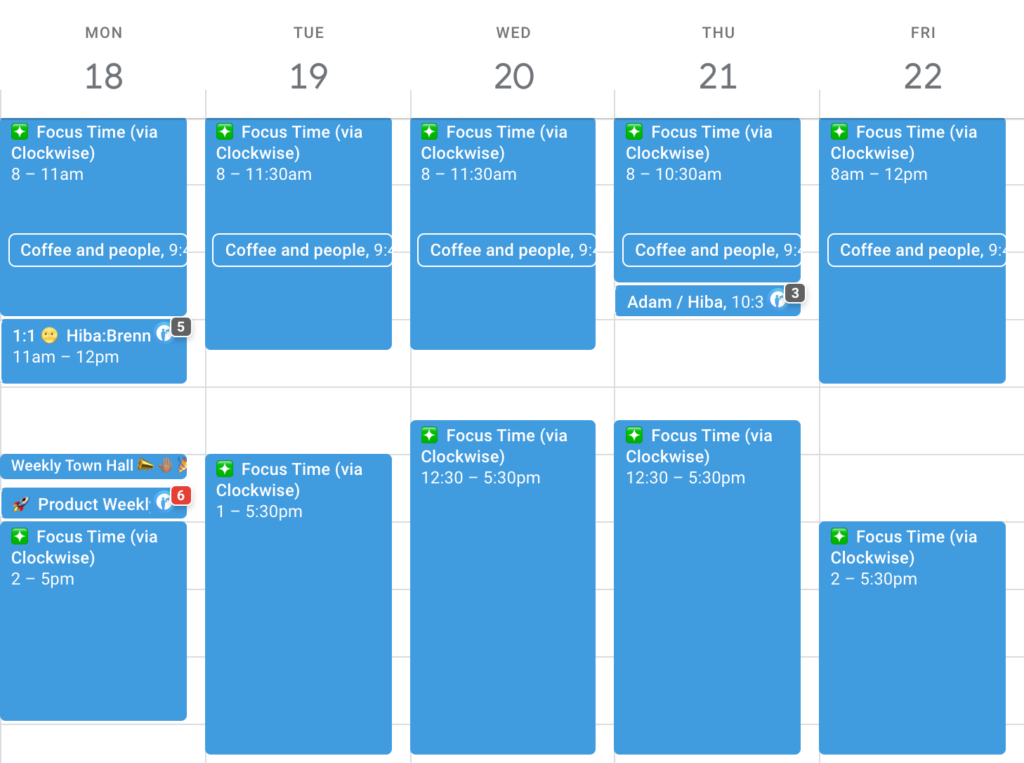
(Hiba’s calendar pre-interviews)
But, in the midst of hiring, my calendar got booked up with a slew of meetings every week.
Bye-bye focus time.
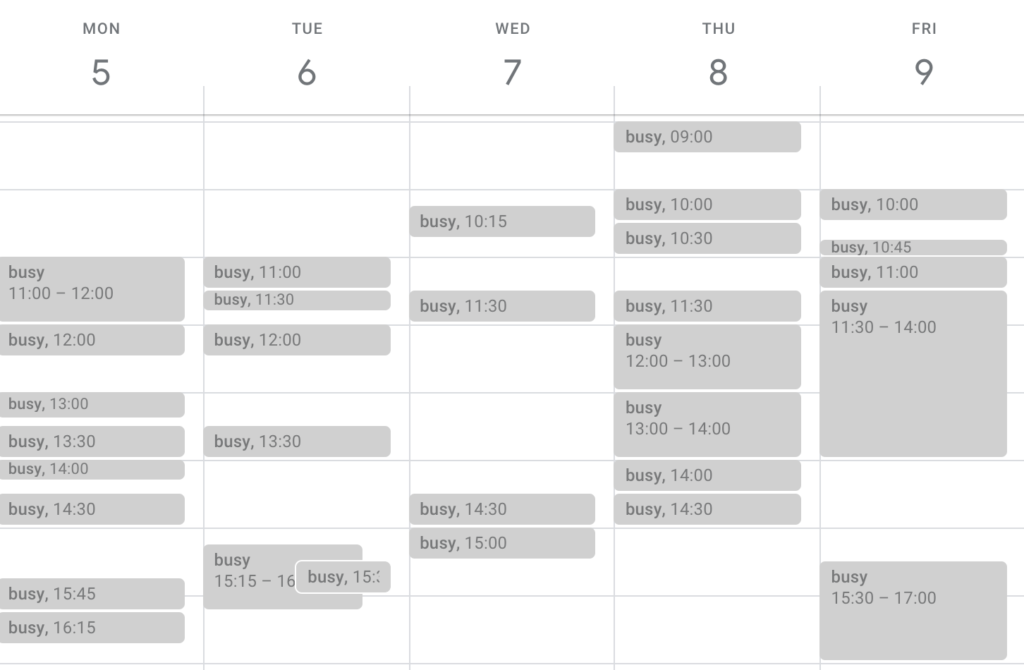
(Hiba’s calendar during interviews)
Not only does it take a toll on you mentally to be giving each candidate 100% of yourself, but you feel less productive as a result. Not to mention the emotional toll it takes to reject candidates in a meaningful way, but more on that later.
Key takeaway #1:
Hit the ground running, but do it at a reasonable pace. Block off hours for yourself every week for things like lunch, mental breaks, and productivity blocks.
Not to mention, you’ll also need to block off time to let candidates know if they’re moving on to the next round or not (and what next steps are!)
#2 Reminder: Hiring is your job
Before hiring, your day-to-day feels a lot more productive.
- You can crank out 3-5 blogs per week
- You’re able to write 400 lines of code every sprint
- Your average time-to-close a ticket was 5 minutes
But, once hiring starts, it’s unrealistic to expect that same level of productivity to continue. That’s why it’s important to remind yourself that hiring is productive.
You can do this by:
- Setting goals for yourself (review 100 resumes by the end of the day)
- Reach out to and schedule the first round of interviews with top candidates by the end of the week
- Have an offer out within 30 days of the first screening call
Having goals will help you measure your progress (and feel productive as a result!)
While it’s time-consuming, it’s still productive
Don’t get me wrong, hiring is a productive effort because of the results it will yield once an offer is signed (when done right) and the employee is onboarded. But, you don’t get the instant satisfaction that you’re used to getting with contributor-type work.
That’s why it’s so important to remind yourself that hiring is your job now and, while it might not feel like it at the moment, it’s productive.
Throughout this process, you’re making a BIG and costly business decision that will ultimately help the business grow. This isn’t an A/B test that you can approach with the classic startup mindset of “fail fast and learn.”
Failing here means you’re okay with hiring and firing people until the right person comes along. That’s not okay.
Take your time throughout the process. Don’t settle on a candidate (and don’t let them settle either).
Key takeaway #2:
It’s okay to feel less productive during the hiring process. It doesn’t mean, however, that your actions aren’t productive. Expect less output and productivity in the short-term in exchange for more in the long-term.
#3 Have a process in place before you post the job
If you want to ensure you’re selecting the right candidate, it’s important to truly understand what you’re looking for. This means that you should have the following documented before you hit “post” on the job description:
- Outcomes: What will success look like for this person? How will their success be measured?
- Scorecard: What qualities, soft skills, and technical skills are most important for success in this role?
- Interview steps: How many rounds of interviews will you need to make a decision? What will each round entail? Who will be involved at each step?
- A standardized list of interview questions: What questions will you ask every candidate?
Let’s walk through what we used at Spinach AI when hiring a Content Marketing Manager. These documents were adapted from SMARTtools for Leaders™ templates. The information shown has also been altered.
Candidate scorecard
Here’s a list of the information to include for each candidate:
- Candidate name
- Date of interview
- Rating and contexts (A, B, C, etc)
- Recommendation (should they move on to the next round?)
Here’s a list of the standardized information to include on the scorecard across every candidate:
- The mission of the role
- Desired outcomes/how they’ll be measured on success
- Desired competencies (technical, hard, and soft skills)
Here’s what it looks like all together:
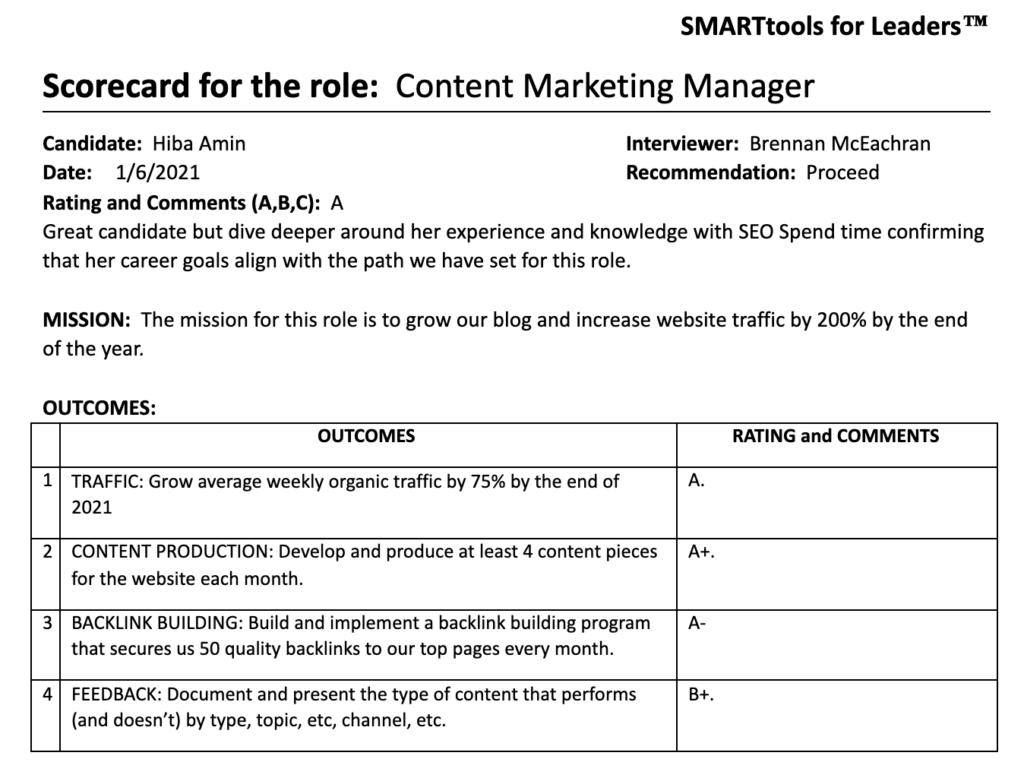
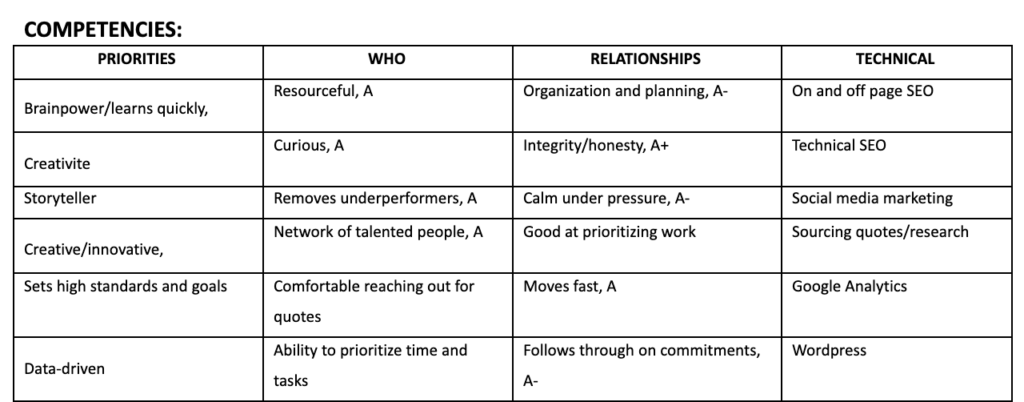
At Spinach AI, we only move forward A-level candidates. These are candidates who we would score an 8/10 or above.
Standardized questions
While these will differ from role to role when it comes to the technical/skills-focused interviews, at Spinach AI we typically keep our screening call questions the same across the board. Here’s the template we use across all of our screening interviews:
Key takeaway #3:
Having a process in place will help you take a very chaotic and balancing-act-type experience and turn it into one that’s an organized flow. When you’re able to feel prepared for every single conversation, you’re more likely to succeed in hiring the right person.
#4 Encourage candidates to ask questions
Remember that candidates are interviewing you just as much as you’re interviewing them.
But, just as you’re creating a psychologically safe space with your direct reports, it’s important you do the same across the interview process.
How we created a safe space for candidates to ask questions and be themselves
At the start of every screening call, Spinach AI hiring managers will say some form of the following message:
I wanted to share the goal of this call. Ultimately, we just want to learn what your career goals are and make sure that not only is there a fit from your skills, but that we can facilitate a path for growth for you.
Before I dive into our questions, I want to preface that there really aren’t any right or wrong answers. So, we’ll take turns, I’ll ask my 6 standard questions here and then I’ll open up the floor for you to grill me! How does that sound?
That final sentence “you can grill me” puts a smile on every candidate’s face. Using humor really helps ease people into the conversation. As a result, I’ve been asked anywhere from 3-7 questions about the role, culture, position, and team from each candidate.
If a candidate is grilling me, I take it as a sign that they not only care about their next step but that they feel comfortable asking questions.
My biggest flex to date in my journey of becoming a manager was when a candidate shared in an interview that the entire Spinach AI team made them feel safe and comfortable to be themselves and get the answers they needed to evaluate the role.
If you’re looking to set some goals as you enter your next hiring process, making candidates feel safe should definitely be on the list.
Key takeaway #4:
Create a psychologically safe space for every candidate to be themselves. This will make it easier for them to open up and ask the questions they need answered to make the right decision for them. Use jokes and be vulnerable to ease the mood and set the tone for open, honest communication.
#5 Your relationship goes beyond one interview process
With every interview process you run, it’s important that you understand that your relationship with candidates doesn’t end when you say yes or no.
If they had a great experience, they’ll remember that the next time a role opens up. They’ll recommend relevant and talented friends or apply again themselves.
If they left feeling sour because of how you treated them, that will affect your entire employer brand. If they hear anyone mention being excited about a role at your company… Chances are they’re not going to be encouraging and excited for that individual.
Careers are lifelong so be sure to leave a good impression with every person who enters your interview process.
Let’s walk through 3 ways to do this:
- Share feedback with every candidate
- Don’t use a boilerplate rejection letter
- Help open doors for candidates
Every candidate deserves feedback
Similar to manager-employee relationships, feedback sharing is the key to building trust and improve performance.
Sharing feedback with prospective employees not only gives them closure, but also enables them to improve for the next interview.
If you spent time talking to a candidate who isn’t moving forward, don’t use a boilerplate rejection letter. The least you can do is share your reasoning.
A lot of managers lean towards not doing this because they don’t want to deal with a candidate who disagrees with their decision. They also just don’t want to be called an “asshole.”
Honestly… Valid.
Also, it’s a time-consuming task so some managers just default to laziness because its’ easier to use a boilerplate template.








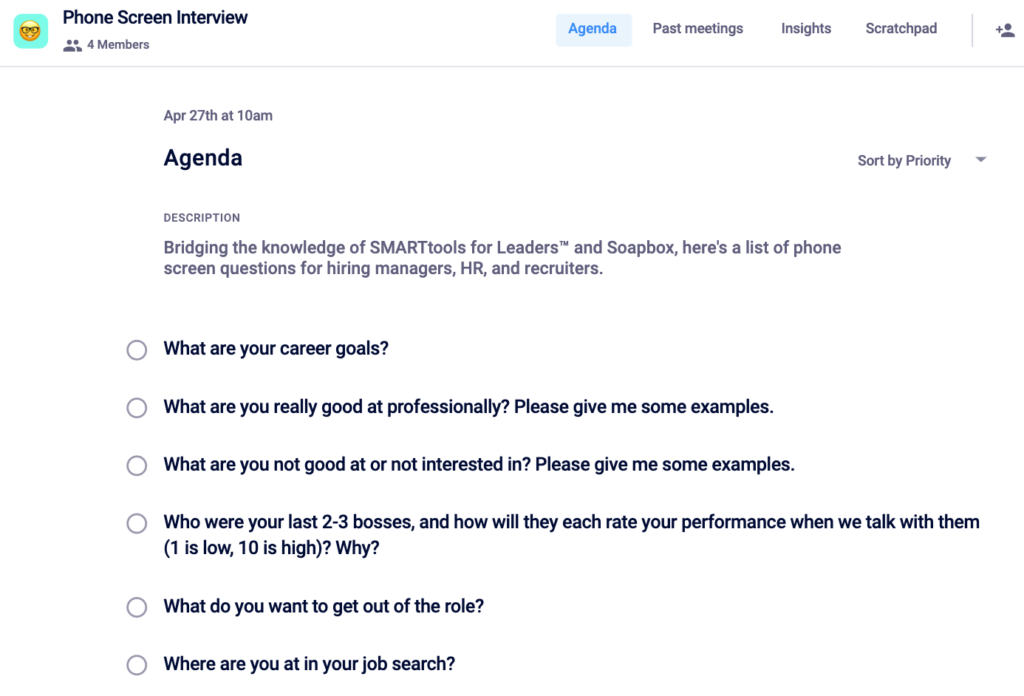

Replies to This Discussion